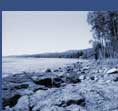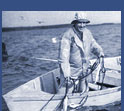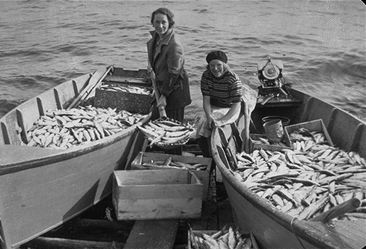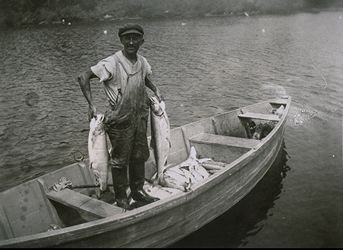 |
    |
|||
Plan Your Visit
|
Virtual Tour: The FishLake trout and herring were the two predominant commercial fish on the North Shore of Lake Superior. Whitefish, important on the south shore, lacked proper habitat along this rocky coast. HerringIn contrast to their name, these fish (Coregonus artedii) are less related to ocean herring than to their larger relative, the lake whitefish (Coregonus clupeaformis). They are gregarious, occurring in schools. They feed on insect larvae and other aquatic invertebrates, and are an important prey species of lake trout. In the late 1880's, herring was used primarily as a bait fish for trout hook lines but by 1910 it was the leading commercial fish on the North Shore.
TroutLake trout (Salvelinus namaycush) are found only in clean, cold northern lakes. They are large predators, eating a range of smaller fish species. Records of fish over 100 pounds exist, though most of those caught were much smaller. These slow-growing fish can live for more than 60 years. They spawn in fall over rocky bottoms near shoreline, but prefer the cold, deep waters offshore in summer. Lake trout flesh is somewhat oily, light pink to almost orange in color and tastes similar to salmon. In addition to geographic variation within the lake, two distinct types were recognized in Lake Superior. In addition to the normal trout, the siscowet was found at great depths and had such oily flesh that it had to be smoked before it was edible.
Sea LampreyThe increasing population of sea lamprey in Lake Superior in the 1950's greatly harmed the trout populations, and effectively ended their commercial harvest. Lampreys were originally prevented from reaching the Great Lakes by Niagara Falls. With the construction of the Welland Ship Canal in 1835, lampreys began to make their first inroads into the eastern lakes, and steadily moved west. They first appeared in Lake Superior in the 1940's. Sea Lamprey are an eel-like form with a sucking disc that is used to attach itself to prey. Once attached, the lamprey bores a hole through the skin and sucks the blood of its prey. next: Techniques |
|||
 |
||||
|
Plan Your Visit | Events & Programs | Exhibits | Collections | Museum Store | Membership | About Us | Home © copyright 2003, North Shore Commercial Fishing Museum. http://www.commercialfishingmuseum.org web design by homepage design |
||||

